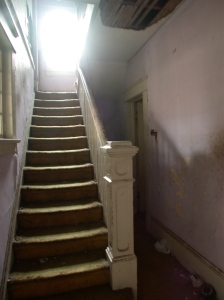House Histories
House Histories
You live in a historic house, but don’t have any real information about its past, aside from a paragraph in a National Register district nomination and the approximate construction year on your tax bill. There is obviously so much more to know about a building. So how do you learn the history of your house? 4/1 Design happily writes up House Histories for interested homeowners – and here’s an outline of exactly what goes into researching one, in case you want to take it on yourself.

We started doing House Histories to go along with the required documentation for Preservation Durham’s historic plaque applications. We also think they’d make a pretty great gift for that hard-to-shop-for loved one, or for a small business owner who operates from an old building.
A successful House History research project involves a combination of persistence, patience and a good instinct for sources. A few journeys down research rabbit holes also help.


Here in Durham, the first place to go for information on a building is always OpenDurham. The free website, started and maintained by Gary Kueber, is a
It’s always a good idea to look at the full National Register nomination for a house to glean interesting background neighborhood information and search for clues for architects.
Not every building will have photos or articles, so a is a surefire way to document
Equipped with a list of past owners, we then turn to the city directories to see if the owners were also the home’s occupants. Thanks to Durham’s universities and economic ups and downs, many
We once dated a home’s second story addition by comparing addresses and occupants in
While city directories only list the homeowner and adult family members, census records show the entire household, including everyone’s ages. I’ve found that ancestry.com is the easiest way to look up individuals in the census records. Given changes to street names and numbers, misspellings of family names, and difficult handwriting from the past, this can be a tricky source to comb through.
Sanborn Fire Insurance Maps are one of our personal favorite tools for research. (


After building plans—which are next to impossible to find for most homes—the most
While there’s an ever-increasing collection online of digitized photos, physical archives can also be essential for a project. Duke University has a lovely archive and helpful librarians. When I go to an archive, I always take my iphone to with me to snap reference photos of photos and documents. It’s faster than making copies (if that’s allowed at all) and is more accurate than notes, which I also take. You also get to feel like a Cold War-era spy stealing classified documents!
Newspaper archives can yield articles with interesting tidbits about the home and its occupants, though they can be especially tedious to search. The Bassett House was used as a designer showcase for the Women’s Junior league in 1976, and several articles with interior photos (a very rare bird) were published. The Durham County Library has microfilm records of all of the Durham newspapers.
While you’re digging around in newspaper records, check for the obituaries of early owners. It can be easier to start with county records and cemetery listings for birth and death dates first. There are a fair number of grave entries listed on this cemetery census site. I always start with Mapleview Cemetery, as that was the main public cemetery in Durham for many decades.
Once the collection of owners/occupants, deed and census records, maps and any photos or newspaper articles is complete, the writing begins! Our goal is to create a narrative combining the physical history of the house with that of those who lived there. As local historians, we are able to link various properties and people we’ve researched previously. We are also able to draw connections between important events in a homeowner’s life and changes in to the structure. For example, after the death of a spouse, the house may be sold or cut up into apartments. Knowing the exact date of precipitating life events helps date alterations, which makes for a richer—and more accurate—story.
Sometimes there’s a lot, sometimes there’s a little, but there is always a story to tell. Drop us a line and let’s get started on your home!
Book a Consult
hi.there@fouroverone.com (919) 339-1411
Office Address: 1235 Berkeley Ave, Durham, NC, 27701
Mailing Address: P.O. Box 355, Durham NC, 27702


































